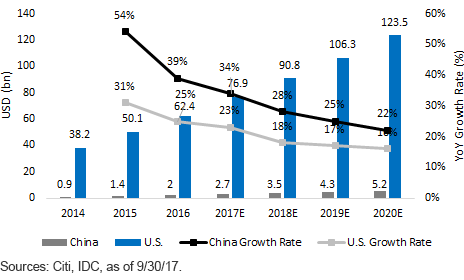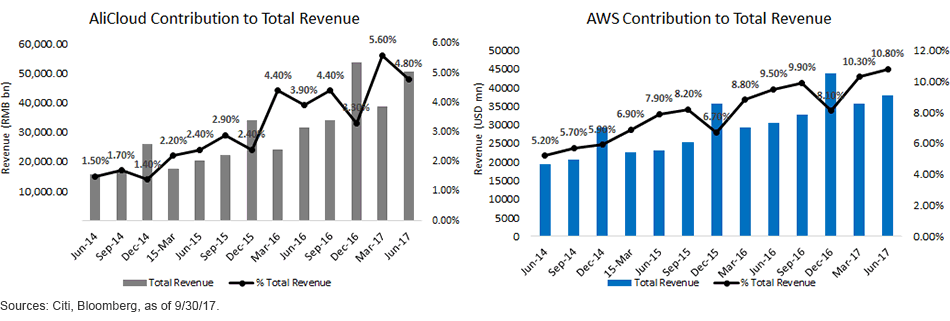Portfolio Insights: China to Embrace the Cloud


For most investors, 2017 will likely go down as the year of technology. It was the strongest-performing sector in nearly every country and region, and if an index or manager was under-weight the tech, it’s extremely unlikely that they were able to outperform their benchmark. At WisdomTree, our best-performing strategy on an absolute (and relative) basis against its market capitalization-weighted benchmark has been our China ex-State-Owned Enterprises Fund (CXSE). Year-to-date, the Fund has returned an impressive 67% compared to a 47.7% return for the MSCI China Index.1
The key driver of those returns? Given that our Index methodology eliminates businesses with greater than 20% government ownership, the resulting portfolio is over-weight tech through our 9.2% and 8.8% weight in Alibaba and Tencent, respectively.2 For most tech investors, one of the most exciting attributes of these businesses is the fact that they’re creating new tools that seek to change the way we live. One such industry that has caught investors’ attention is cloud computing. Below, we contrast the current state of the cloud in the U.S. and China and then try to discern what it may mean for CXSE. In our view, Alibaba’s and Tencent’s cloud-based technology could reach levels of dominance in Asia not dissimilar to Amazon’s and Microsoft’s dominance through much of the developed world.
Macro Trends
In order to remain bullish on China and the ex-SOE theme, it’s imperative that investors be aware of what’s driving current earnings but also how they’ll grow into their elevated multiples (approx. ~30x forward P/E3). As we’ve seen in most tech high fliers, their ability to meaningfully pivot outside of their core businesses has separated businesses such as Facebook from those such as Snap. Central to our views on China tech are the trends we’re seeing in cloud computing.
In a chart first presented by Citi, we compare the relative size of the public cloud market in the U.S. vs. China. Unsurprisingly, the market in the U.S. dwarfs that of the Chinese by nearly 30x.4 However, given its smaller base, we see dramatically higher growth rates in the Chinese market. Additionally, we believe the cloud could be ground zero for China’s stated goal of transitioning from a manufacturing and trade-based economy to one comprising primarily consumption and services. In fact, we’ve heard several times over the last couple of years that the Chinese government is actively pushing SOEs as well as smaller firms to embrace technology by migrating segments of their business into the cloud. In only three years’ time, the International Data Corporation (IDC) predicts that the U.S. advantage will have narrowed to only 23x. As growth in the U.S. begins to plateau at around 16% per year, China’s growth will continue to accelerate. While China currently represents a smaller segment of the global market, we believe Chinese firms may possess a structural advantage when growing the cloud in Mainland China as well as across Southeast Asia.
U.S. vs. China Public Cloud Market

Amazon & Microsoft vs. Alibaba & Tencent
In the U.S., Amazon Web Services (AWS) dominates cloud computing by controlling nearly 40% of the market. Its closest competitor, Microsoft Azure, currently controls 11%. In China, Alibaba’s AliCloud (41%) and Tencent Cloud (7.1%) provide an apt comparison to concentration in the market.5 However, there are two main reasons AliCloud currently generates only 10% as much revenue as AWS: the slope of the adoption curve and geographic focus. Given the lack of penetration in China by Western tech firms, we believe that the natural oligopoly of AliCloud and Tencent could benefit if recent efforts by the Chinese government to push more SOEs, government agencies and private businesses into the cloud intensifies.
Given its small contribution to revenue, why should Chinese tech investors care about the cloud? Using AWS’ experience in the U.S., growth in this part of Amazon’s business has garnered significant attention from analysts and served as a powerful diversifier from its core e-commerce business. With Alibaba following a similar business model and Tencent focusing on online services/entertainment, we believe the cloud can have even greater impact for their businesses. This view is largely borne out by the figures below.
In each chart, we plot the total revenue growth trajectory as well as the overall percentage of firm revenue from AliCloud and AWS. While AWS currently contributes more than 10% of revenue with larger notional amounts, it appears that Alibaba may be only three years behind in terms of their contribution to total revenue. Recall that AWS launched in 2006, a full three years before AliCloud. If AliCloud can continue to mimic Amazon’s performance in the Chinese market, our thesis about the rise of the cloud in China could bear fruit.

What About Expenses?
Compared to other fast-growing pockets of tech, massive capex and significant cash burn can lead to considerable pain if not monitored closely. Another strong catalyst that we believe could be beneficial for Alibaba’s (and Tencent’s) bottom line is the fact that a large percentage of the physical investment in data centers across Mainland China has already been completed. For the projects that remain, the government’s “One Belt, One Road” initiative could help spur increased investment in the region with cheap government capital, with a combination of both physical and digital trade linkages enhancing efficiency across Southeast Asia as a result. To that end, Citi currently estimates that AliCloud’s GAAP operating income could go positive by as early as Q3 2018, then doubling margins to 6% the following quarter.6 Going forward, firms will seek to differentiate their capabilities through software and marketing of their platforms. Here again, we believe Chinese firms’ geographic proximity may provide a leg up against Western competitors such as AWS.
In sum, cloud computing seems to be expanding at nearly double-digit rates in China even as official government growth targets stabilize below 7%. While the cloud represents a comparatively small part of China’s economy and Alibaba’s revenue, we believe that both trends may be poised to continue to grow. Any investment predicated on disruptive technology unseating conventional approaches is fraught with risk. But as the trend in e-commerce increasingly migrates to the cloud, we believe Alibaba and Tencent could continue to be the primary beneficiaries as their offerings gain market share against Amazon and Microsoft.
1Source: Bloomberg, as of 10/31/17.
2Source: WisdomTree, as of 10/31/17. Holdings subject to change. For current holdings of the China ex-State-Owned Enterprises Fund, visit the CXSE page.
3Source: WisdomTree, as of 10/31/17.
4Source: IDC data, as of 9/30/17.
5Source: Citi, as of 9/30/17.
Important Risks Related to this Article
Click here for CXSE standardized performance.
Performance is historical and does not guarantee future results. Current performance may be lower or higher than quoted. Investment returns and principal value of an investment will fluctuate so that an investor’s shares, when redeemed, may be worth more or less than their original cost. Performance data for the most recent month-end is available at www.wisdomtree.com.
WisdomTree shares are bought and sold at market price (not NAV) and are not individually redeemed from the Fund. Total returns are calculated using the daily 4:00 p.m. EST net asset value (NAV). Market price returns reflect the midpoint of the bid/ask spread as of the close of trading on the exchange where Fund shares are listed. Market price returns do not represent the returns you would receive if you traded shares at other times.
There are risks associated with investing, including possible loss of principal. Foreign investing involves special risks, such as risk of loss from currency fluctuation or political or economic uncertainty. The Fund focuses its investments in China, thereby increasing the impact of events and developments associated with the region which can adversely affect performance. Investments in emerging or offshore markets are generally less liquid and less efficient than investments in developed markets and are subject to additional risks, such as risks of adverse governmental regulation and intervention or political developments. The Fund’s exposure to certain sectors may increases its vulnerability to any single economic or regulatory development related to such sector. As this Fund can have a high concentration in some issuers, the Fund can be adversely impacted by changes affecting those issuers. Please read the Fund’s prospectus for specific details regarding the Fund’s risk profile.


